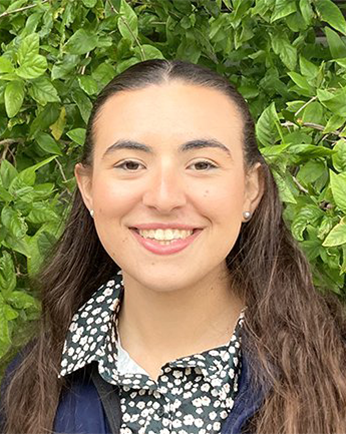Poster Presentations:

PhD Student
Western Michigan University
Presentation Title: Numerically Investigating the Effects of RTWC Types on the Wind Resistance Performance of Light-Frame Roof Structure
Co-Author: Xiaoyun Shao
Abstract: The critical role of roofs in protecting light-frame wood residential buildings from strong wind events continuously reminds us the importance of understanding its wind resistance performance. Previous experimental research demonstrated that applying adhesive to roof-to-wall connection (RTWC) approximately doubled the uplift capacity when compared to conventional toenail RTWC. To further understand adhesive RTWC’s effect on the wind resistance performance of roof structural system, a numerical investigation is carried out and introduced in this presentation. Two complete three-dimensional gable truss residential roof models were developed in Abaqus, including roof sheathing modeled by shell elements, trusses and top plates modeled by framing elements and the two types of RTWCs modeled by nonlinear connectors RTWCs. Experimental force-displacement relationships of adhesive and nail RTWCs were used to defined the connectors’ behavior. A step pressure load was firstly applied normal to the sheathing panels to examine model’s stability, geometric symmetricity, and equilibrium. Then, monotonic pressure load was applied to both adhesive and nail roof models to identify the failure pressure and investigate RTWC’s effect on roof responses including stresses and deformations. Finally, a realistic wind pressure history load was applied to further reveal roof systems’ dynamic responses with two types of RTWCs. Preliminary results showed that replacing adhesive RTWCs reduces the stresses and deformations in sheathings by 136% and 131%, respectively when compared to conventional toenail RTWCs. In addition, the adhesive roof system’s wind pressure capacity was found to be four times the capacity of the nail counterpart. This numerical investigation is still ongoing and it is expected more results will be presented during the workshop next year.

Undergraduate Student
Embry-Riddle Aeronautical University
Presentation Title: Deep Learning-Based Estimation of Peak Wind Pressures on Buildings from Short Duration Measurements
Co-Author: Abiy Melaku
Abstract: This research presents a deep learning model to predict peak pressure coefficients on building surfaces from short duration wind tunnel measurement data. The model is trained using pressure coefficients measured on a tall rectangular building having upstream exposure conditions of open terrain. The wind directions vary from 0 up to 90 at an increment of 5. For the deep learning model, a multi-layer perceptron model is created that takes several statistical properties of the wind pressure fluctuations as input. Then, the model was trained, validated and tested for several configurations to predict peak fluctuations. Overall, the model yields reasonably accurate estimates with an average prediction error of 2.78% and a 3.47% for positive and negative peak pressure coefficients, respectively. This work is expected to be useful to reduce the cost of running long-duration boundary layer wind tunnel (BLWT) experiments and computational fluid dynamics (CFD) simulations to make reliable estimation of peak loads, which are essential for the wind resistant design of buildings.

PhD Student
Texas Tech University
Presentation Title: Laboratory Study of Tornado-Like Loading on a Low-Rise Building Model
Co-Authors: Anamika Malla; Jiping Kang; Hui Zhang; Xinyang Wu
Abstract: To better understand the characteristics of tornadoes and the tornadic loading on buildings, multiple tornado-like vortices were simulated in the large-scale tornado simulator at Texas Tech University: the 2nd largest tornado simulator in the world. The highly turbulent flow of the vortices was measured to investigate the characteristic of vortices and the wind loading acting on a low-rise building model was tested when the model translated through the simulated tornado-like vortices to simulate the scenarios of a tornado passing over a building. The pressure measurements were used to interpret the variation of the surface pressures on the model along the paths of the translations. The data from the experiments suggest when the model is at or near the center of the vortex along its translation through the center of the vortex, the loading is predominantly caused by the static pressure deficit and the characteristics of the surface pressures closely resemble those of the pressure on the floor under the vortex without the presence of the model. When the model is at the locations where the mean velocity of the flow around the model is over a high range, the aerodynamic induced pressure contributes significantly to the surface pressures, especially over areas that are significantly affected by separation of the flow from the edges of the walls and roof, resulting in negative pressures of large mean magnitudes and large standard deviations.

Postdoctoral Scholar
University of California, Berkeley
Presentation Title: Detached-eddy simulation of wind loads on a ground-mounted solar array
Co-Author: Tracy Becker
Abstract: Significant damage occurs every year to ground mounted solar arrays, often at below design wind speeds. This is primarily due to repeated loading resulting in walking or fatigue of connections. As such, it is important to understand the dynamic cyclical loading on these structures rather than just their peak loads. Detached-eddy simulation (DES) is used to investigate aerodynamic loads on an array of ground-mounted solar photovoltaic (PV) panels with 30° tilt angle immersed in the atmospheric boundary layer. The array has seven rows and two tables per row, which was used in a series of wind tunnel tests. Wind azimuths of the incoming flow vary from 0° to 180° at 30° intervals. The NHERI SimCenter Turbulence Inflow Tool (TInF) is adopted to reproduce the characteristics of the inlet wind profiles reported in the experimental tests. The surface pressure coefficients obtained from the DES are compared to the pressure tap data of the wind tunnel tests. The DES and experiment results have good agreement in terms of mean, standard deviation, and frequency contents of pressure coefficients.

PhD Student
University of Central Florida
Presentation Title: Strengthening Community Resilience by Modeling Transportation and Electric Power Network Interdependencies
Co-Author: Samiul Hasan
Abstract: During an extreme event, the resilience of a community is significantly affected by power outages. Resilience is generally defined as the ability of a system to manage shocks and return to a normal state in response to an extreme event. This paper presents an agent-based modeling (ABM) approach to strengthen resilience of a community depending on interdependent infrastructure systems. In this ABM approach, autonomous agents represent the components of a system, where internal interactions within each system shape intra-dependency of a system and external interactions among systems shape interdependencies. To study household resilience subject to a hurricane, a library of agents has been created including electric power network, transportation network, wind/flooding hazard, and household agents. The proposed ABM approach is applied to the Zip code 33147 of Miami-Dade County in Florida. Household resilience to power service is estimated considering different power restoration strategies and modeling the interdependency between electric power and transportation networks. We found that resilience to power service can be significantly improved with alternative restoration strategies and by building a resilient transportation system. The developed agent-based model can be used as a decision-support tool by policy makers and emergency management officials in evaluating power restoration strategies using available resources.

Associate Professor
University of Alabama
Presentation Title: Deep learning classifier for tornado damage assessment
Co-Author: Carlos Canchila Martinez
Abstract: Accurate and fast tornado damage assessment is critical to create adequate post-disaster response and recovery strategies. Current damage assessment practices rely on human evaluation to determine the extent of damage across buildings at disaster sites based on visual clues. However, human evaluation is time-consuming, and its subjective nature can lead to biased assessment. Recent advances in deep learning could enable the automation of damage assessment tasks. Nonetheless, leveraging the full potential of deep learning requires large amounts of data and significant training times. To address these issues, this study proposes a deep learning image-based network to classify the degree of damage from photos taken after tornado events. This approach reduces the subjectivity associated with human evaluations, providing rapid, objective, and consistent assessments of damage severity. Furthermore, transfer learning is adopted to enhance network performance by simultaneously reducing data demands and training times. The weights of deep learning networks from the NHERI-SimCenter BRAILS module are used as a baseline for the proposed network. The proposed deep learning network is trained and tested on a dataset containing images with various building types and tornado damage. The results of this study demonstrate the capability of deep learning networks for post-event damage classification and the advantages of using transfer learning to improve network performance.

Assistant Professor
Washington State University
Presentation Title: Hurricane Trajectory Synthesis using Conditional Neural Network
Abstract: Hurricane trajectory synthesis plays a pivotal role in hurricane risk assessment, code design, and coastal planning. Traditional regression-based models have been widely utilized for hurricane track synthesis. However, they exhibit limitations in capturing intricate nonlinear relations inherent in atmospheric processes. In contrast, machine learning models have shown exceptional prowess in mapping these complexities. However, a significant limitation of prevailing machine learning methods is their grid-centric nature. Specifically, traditional neural network models necessitate individual training for each grid on a map, which undermines the optimal use of training data. In this paper, we developed a cutting-edge method rooted in Conditional Neural Networks (CondNN) for synthesizing hurricane trajectories. Unlike the conventional grid-focused approach, where each map grid requires its unique trajectory prediction model, our proposed CondNN offers a more generalized trajectory prediction model. This model takes pivotal parameters such as location, sea surface temperature, and surrounding atmospheric flows as direct inputs. By being a generalized model, it paves the way for a deeper analysis into how each parameter influences the hurricane's trajectory. Preliminary results indicate that this conditional approach is adept at efficiently capturing nonlinearities. Moreover, it offers insightful perspectives on pinpointing which parameters are most influential in determining hurricane behavior.